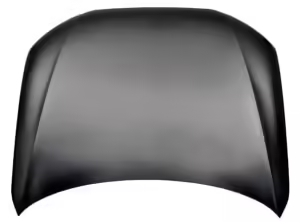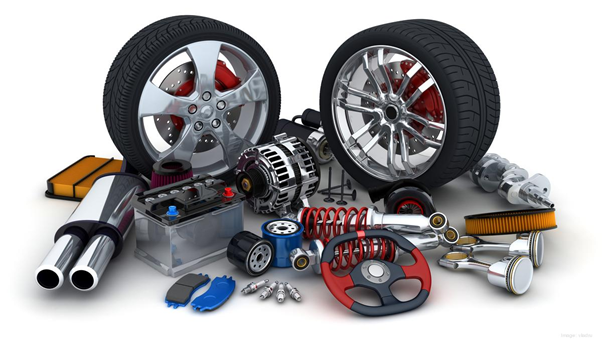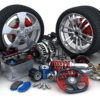A Beginner’s Guide to Car Body Parts: What You Need to Know
Understanding car body parts is essential for every vehicle owner, especially when it comes to repairs, maintenance, or upgrades. Whether you’re involved in a fender bender or want to improve your car’s appearance, knowing the basics of car body parts can help you make informed decisions and save money. This beginner’s guide covers the most important car body parts, their functions, and why they matter.
1. Bumpers:

Bumpers are mounted on the front and rear of your vehicle and are designed to absorb the impact from minor collisions. They protect vital parts like the engine, radiator, and trunk from damage. Modern bumpers are typically made of plastic, rubber, or lightweight metals and often come with additional features like sensors or lights.
- Why They Matter: Bumpers play a crucial role in safety and preventing damage to other parts of your vehicle during low-speed impacts.
2. Fenders:

Fenders are the panels that sit above your vehicle’s wheels. They help keep dirt, debris, and road water from being thrown into the air by your tires, protecting both your vehicle and other drivers. Fenders are also an important part of your car’s overall design.
- Why They Matter: Fenders prevent road debris from causing damage to your vehicle and other vehicles on the road. They also add to the vehicle’s appearance.
3. Hood

The hood is the hinged cover that sits over the engine bay. It provides easy access to the engine and other critical parts like the battery, alternator, and fluid reservoirs. Typically made of steel or aluminum, the hood shields the engine from outside elements such as rain, dirt, and debris.
- Why It Matters: A properly functioning hood protects your engine from external damage and helps with vehicle aerodynamics.
4. Grille:
Located at the front of your vehicle, the grille allows air to flow into the engine bay, helping to cool the radiator and other key components. Grilles are often a distinctive design feature of cars and come in various styles depending on the model.
- Why It Matters: Besides aesthetics, the grille plays a functional role in keeping your engine cool by facilitating airflow.
5. Doors:
Car doors serve as an entry and exit point for passengers and are crucial for safety. They include several components like locks, handles, windows, and mirrors. Modern car doors are often equipped with electronic features, such as power windows or keyless entry.
- Why They Matter: Car doors protect passengers during accidents and offer essential convenience features like windows and mirrors.
6. Side Mirrors:
Side mirrors are located on the left and right sides of your vehicle, giving you a view of the areas behind and beside your car. These mirrors help you safely change lanes, back up, and navigate traffic. Many modern side mirrors come with features like heating, power folding, and turn signals.
- Why They Matter: Side mirrors provide visibility of blind spots and enhance overall driving safety.
7. Windshield
The windshield is a large glass panel that provides visibility for the driver and protects the vehicle’s occupants from wind, rain, and debris. It also contributes to the structural integrity of the car. Made from laminated safety glass, windshields are designed to minimize injury in case of breakage.
- Why It Matters: A clear, intact windshield is essential for driver visibility and safety. It also adds to the car’s structural strength in accidents.
8. Trunk Lid:
The trunk lid provides access to the trunk and is essential for securing cargo. Like the hood, the trunk lid is typically made of steel or aluminum and includes a locking mechanism to protect your belongings.
- Why It Matters: It keeps your cargo secure and adds to the overall functionality and security of your vehicle.
9. Headlights and Taillights:
Headlights and taillights are crucial for visibility and safety, especially during nighttime or bad weather. Headlights illuminate the road ahead, while taillights let other drivers know you’re braking or turning. Many modern vehicles also include LED or xenon headlights for enhanced visibility and energy efficiency.
- Why They Matter: Headlights and taillights improve visibility for both you and other drivers, making them essential for safe driving.
10. Quarter Panels:
Quarter panels are the exterior side panels of your car, located between the door and the rear bumper. They are often one of the most vulnerable parts in side or rear-end collisions. Quarter panels add structural integrity to the vehicle’s body and are crucial for its overall appearance.
- Why They Matter: Quarter panels provide structural support and protect other components from damage in the event of a collision.
Why Knowing Car Body Parts Is Important
Understanding your vehicle’s body parts is important for several reasons:
- Maintenance: Regular maintenance of car body parts helps keep your vehicle looking good and running safely. For example, damaged headlights can reduce visibility at night, while a cracked windshield can compromise your safety.
- Cost Savings: Knowing when and how to replace car body parts can save you money in the long run. Understanding the difference between OEM and aftermarket parts can help you make more cost-effective decisions.
- Safety: Body parts like bumpers, fenders, and mirrors play a critical role in protecting you and your passengers in the event of an accident.
- Resale Value: Keeping your car’s body parts in good condition can help maintain its resale value. A well-maintained exterior is more appealing to potential buyers and signals that the car has been well cared for.
Conclusion:
Being familiar with your car’s body parts can make a significant difference in how well you maintain and care for your vehicle. Whether you’re replacing a damaged part, upgrading your car’s look, or simply keeping everything in working order, understanding these essential components is the first step toward smart vehicle ownership. By knowing what each part does and how to maintain it, you can extend the lifespan of your vehicle and ensure it stays safe, functional, and attractive.













